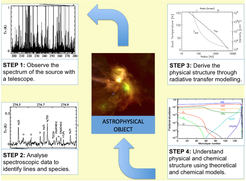CAS@MPE Motivation
The new generation of telescopes and high resolution spectrometers in the millimetre, sub-millimetre and infrared bands have started to provide a wealth of atomic and molecular data, underlining the need for accurate determination of transition frequencies (Widicus Weaver et al. 2013), collisional/rate coefficients, and astrochemical modelling predictions. Only then can we correctly interpret observations and advance our understanding of the near and far universe, as well as our origins (Caselli & Ceccarelli 2012; Ceccarelli, Caselli et al. 2014).
Exploiting the full capabilities of the Herschel Space Observatory, the IRAM 30m antenna and Plateau de Bure Interferometer (PdBI, future Northern Extended Millimeter Array, NOEMA), the Atacama Large Millimetre/sub-millimetre Array (ALMA), the Atacama Pathfinder EXperiment (APEX), the Stratospheric Observatory for Infrared Astronomy (SOFIA), the Karl G. Jansky Very Large Array (JVLA), the future Square Kilometre Array (SKA), with their broadband spectral acquisition capabilities, represent daunting challenges for the present and future generation of astrophysicists.

As shown in the figure, spectroscopic observations can be properly interpreted only if the lines are well identified and if radiative transfer and chemical/physical models (steps 2-4 in the figure) are well understood. As tools for data interpretation are lacking, much effort has to be devoted to steps 2-4 to fully exploit the data from the best instrumentation ever built.
This is the motivation behind the Center for Astrochemical Studies (CAS) at MPE, whose structure is explained here.
